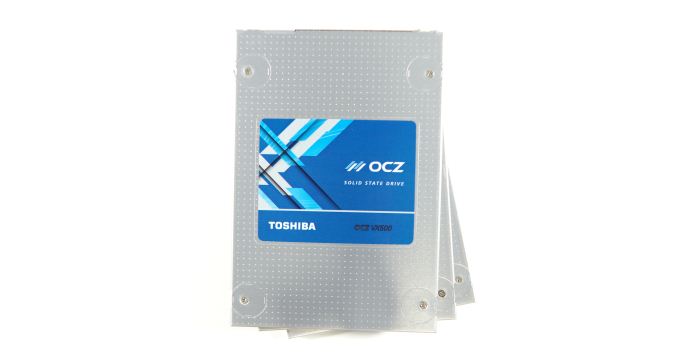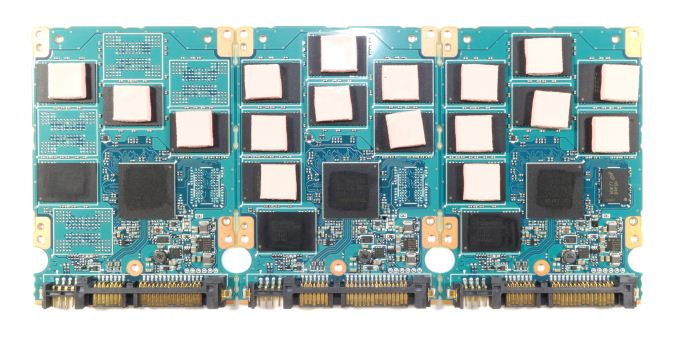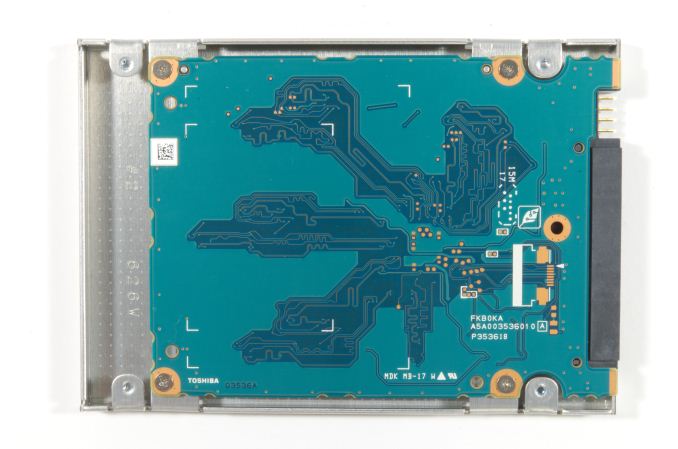The Toshiba OCZ VX500 (256GB, 512GB, 1024GB) SSD Review
by Billy Tallis on September 13, 2016 9:00 AM EST
Toshiba's new OCZ VX500 is launching into what has been the quietest corner of the SSD market: SATA drives using MLC NAND flash. The fiercest competition has been among low-cost TLC SSDs and the PCIe SSD segment has seen several new entrants in recent months, but the mid- to high-end portion of the SATA SSD market has been in a holding pattern awaiting new 3D NAND. The OCZ VX500 is not a new 3D NAND SSD but a stopgap product to replace the aging OCZ Vector 180, known as the VT180 since Toshiba's overhaul of OCZ branding earlier this year.
The Barefoot 3 controller in the Vector 180 is ancient, having launched with the original OCZ Vector in 2012. At the time, it performed well enough to go up against Samsung's best in the consumer market and was viable in the enterprise market. As the market has moved on and caught up, the limitations of the Barefoot 3 controller have become increasingly awkward. Most prominently, it does not support SATA link power management and consequently products based on it have by far the worst idle power of any consumer SATA SSD on the market. It was never intended for use with TLC NAND or 3D NAND, and may not even be able to work with Toshiba's 15nm MLC NAND.
The OCZ VX500 abandons the Barefoot 3 controller and its Indilinx heritage entirely, but the controller it uses instead is also a reprise, this time of a Toshiba controller. Toshiba's TC358790 controller has been used in several products, including the Q Series Pro client SSDs and the HG6 enterprise/OEM SSD. Toshiba doesn't disclose details of their controller architectures, but we can infer a few things based on those earlier products. The TC358790 controller has previously always been limited to drive capacities of up to 512GB, and has only been used in client SSDs or read-oriented enterprise SSDs. Unlike the Barefoot 3 controller, this was never intended for a flagship high-end product. It supports the TCG Opal encryption standard and Toshiba's proprietary QSCB error correction scheme, but neither technology is mentioned in the official specifications for the VX500.
At first glance, the TC358790 controller appears to be a DRAM-less controller. However, the drive PCB it always ships on has a pad for a BGA DRAM package. The 1TB VX500 is the first product to make use of that, with the inclusion of a 256MB Micron DRAM chip, whereas the smaller capacities leave that spot empty. Modern SSDs that use a DRAM cache for NAND mapping tables typically have 1GB of DRAM for each 1TB of flash, but it is obviously possible to get by on less, and some demonstrations of the NVMe Host Memory Buffer feature have shown that access to even a little bit of DRAM can help greatly as compared with operating as a purely DRAM-less SSD.
With the knowledge that the 1TB VX500 is using at least 256MB of DRAM, we can compare its performance against the smaller models to see if it has an advantage over the smaller two capacities above and beyond what is typical for a simple capacity increase. For the most part, our test results do not show the drastic difference in behavior that we would expect between a DRAM-less SSD and a controller with a DRAM cache. Thus, it seems that the TC358790 controller may have never been DRAM-less to begin with and instead has integrated sufficient DRAM for SSDs up to 512GB. Toshiba left themselves the option of expanding on the integrated memory with external DRAM, but only now has the market reached the point of requiring a 1TB model.
| Toshiba OCZ VX500 Specifications | ||||||
| Capacity | 128GB | 256GB | 512GB | 1024GB | ||
| Controller | Toshiba TC358790 | |||||
| NAND | Toshiba 15nm MLC | |||||
| External DRAM | none | 256MB | ||||
| Sequential Read | 550MB/s | 550MB/s | 550MB/s | 550MB/s | ||
| Sequential Write | 485MB/s | 510MB/s | 515MB/s | 515MB/s | ||
| 4KB Random Read | 62k IOPS | 90k IOPS | 92k IOPS | 92k IOPS | ||
| 4KB Random Write | 49k IOPS | 58k IOPS | 64k IOPS | 65k IOPS | ||
| Idle Power | 125 mW | 260 mW | ||||
| Max Power | 3.4 W | |||||
| DEVSLP Power | 5 mW | unsupported | ||||
| Encryption | No | |||||
| Endurance (TBW) | 74 TB | 148 TB | 296 TB | 592 TB | ||
| Warranty | Five years | |||||
| MSRP | $63.99 | $92.79 | $152.52 | $337.06 | ||
One apparent downside of the use of external DRAM is a restriction of the drive's power management capabilities. The 1TB VX500 does implement the slumber power state, but it uses more than four times the power in that state. And unlike the smaller capacities, the lowest-power DEVSLP state is not implemented. The 1TB VX500 has vastly better idle power consumption than the Vector 180 at any capacity, but it's still not a great choice for mobile use.
The OCZ VX500 makes use of SLC write caching, which is a requirement for acceptable performance from TLC SSDs but rare on MLC SSDs. SLC caching on MLC SSDs can be a mixed bag; it allows for the highest peak performance, but at the cost of creating more work that needs to be done later to flush the cache. MLC drives in particular often have less spare area for the cache than a TLC drive would, so they may not be able to sustain their burst write speeds for as long. Implemented properly, SLC caching can be very helpful for client workloads which typically exhibit bursts of I/O, but many of our benchmarks are sustained tests that run long enough to fill any SLC cache.
The VX500 is built with the same PCB and case as earlier products based on the same controller. I'm not a fan of the case because its rough edges and corners tend to snag on everything when hot-swapping it between tests, but it's sturdy enough and the all-metal construction ensures there won't be any thermal issues. After fighting past screws that Toshiba used a thread-locking adhesive on, we uncover a single-sided PCB with a thermal pad on the controller and every NAND package. The DRAM on the 1TB model doesn't get a thermal pad. There are no obvious large capacitors, so it appears that the VX500 sacrifices the partial power loss protection the Vector 180 had (protecting only data at rest by preventing NAND mapping table corruption, but not protecting data in flight).
The initial MSRPs Toshiba has set for the VX500 position it below the Vector 180 and just below the Samsung 850 EVO, and both of those comparisons are of the MSRP against current street prices. Toshiba isn't trying to pretend that the VX500 is anything like a flagship product, and there's a good chance it will end up being one of the cheapest planar MLC SSDs once prices settle. Toshiba will be selling a 128GB model, but it is unlikely to get much traction in the retail market, especially with such a high initial MSRP.
MLC NAND is losing popularity with manufacturers in the SATA SSD market, which limits our options for comparisons against contemporary SSDs. There is a recent crop of SSDs using the Phison S10 controller and Toshiba 15nm MLC, represented in this review by the PNY CS2211. The SanDisk Extreme Pro is still hanging around as a high-end SATA option, and the Crucial MX200 is still available but is being replaced by the MX300 based on 3D TLC. For TLC drives we are comparing against the OCZ Trion 150 (now TR150) and the Samsung 850 EVO. Our Bench database can be used to make comparisons against other drives we have tested.
| AnandTech 2015 SSD Test System | |
| CPU | Intel Core i7-4770K running at 3.5GHz (Turbo & EIST enabled, C-states disabled) |
| Motherboard | ASUS Z97 Pro (BIOS 2701) |
| Chipset | Intel Z97 |
| Memory | Corsair Vengeance DDR3-1866 2x8GB (9-10-9-27 2T) |
| Graphics | Intel HD Graphics 4600 |
| Desktop Resolution | 1920 x 1200 |
| OS | Windows 8.1 x64 |
- Thanks to Intel for the Core i7-4770K CPU
- Thanks to ASUS for the Z97 Deluxe motherboard
- Thanks to Corsair for the Vengeance 16GB DDR3-1866 DRAM kit, RM750 power supply, Carbide 200R case, and Hydro H60 CPU cooler


















29 Comments
View All Comments
Chaitanya - Tuesday, September 13, 2016 - link
How is the after sales service of these drives since Toshiba take over? I have heard some horror stories of RMA with OCZ in past.JebSpringfield - Tuesday, September 13, 2016 - link
I bought one OCZ drive a year after Toshiba took over. The SSD failed after one month, and they replaced it with a better model (I had to pay for the shipping), after another month or so, the new drive also failed. I contacted them again but this time I said I was not going to pay for shipping. They agreed, and sent me their top of the line model which has 5 year warranty and it's been working fine (knock on wood) for a bit longer than a year.Sorry but I don't remember the models.
Meegul - Tuesday, September 13, 2016 - link
While that doesn't speak to the quality of the drives, at least the customer service stepped up. The old OCZ days were just fraught with stories about the customer service affectively being MIA.StevoLincolnite - Tuesday, September 13, 2016 - link
...I'm still running a 64Gb OCZ Vertex 2 from 6-7 years ago... I WANT IT TO DIE SO I CAN UPGRADE.gammaray - Wednesday, September 14, 2016 - link
both my ocz vertex III and Agility III are still running fine lol. Meanwhile i bought an assorted battery of other SSDs, Main rig running Sandisk Extreme Pro.creed3020 - Wednesday, September 14, 2016 - link
Likewise! I have that same drive as my boot drive for my HTPC. Its definitely slower than it once was but thankfully it keeps on chugging. My next gen HTPC will include a newer, bigger boot drive. Not sure what will happen to the SATA II drive when I rebuild...Bullwinkle J Moose - Monday, October 3, 2016 - link
A Vertex 2 is Super Easy to KillJust follow OCZ recommendations on upgrading the firmware
(NO, I am NOT joking)
B.T.W.,
Anandtech really needs to update their testing procedure for SSD's
The original Vertex could copy and paste a 2GB file (to and from the same drive) at a blistering rate of 3.6 - 3.7 MB/sec
A Samsung 840 Pro can copy/paste the same file at 56.8 MB/sec
A Samsung 850 Pro can copy/paste the same file at 113.7 MB/sec
YES, AN 850 PRO IS TWICE AS FAST AS AN 840 PRO!
Disclaimer:
ALL tests made with XP-SP2 on SATA2 Ports using IDE protocol
Your results will vary depending on O.S. / Port Type and Protocol
Hardware and O.S. were kept identical to that used when testing the Vertex 1 & 2 which are no longer available for testing on newer hardware
ocztaec - Thursday, September 15, 2016 - link
Hi JebSpringfield,As this is my first post on this article please allow me to identify myself as a Toshiba America Electronic Components (TAEC) representative. Thank you for your comment and great to hear the current replacement drive is working well for you. We greatly appreciate both your business and support.
fanofanand - Wednesday, September 14, 2016 - link
I won't be taking the risk. They refused to honor their warranty when my OCZ DDR2 sticks failed. Lifetime warranty my azz.....ocztaec - Thursday, September 15, 2016 - link
Hi fanofanand,Thank you for your comment and your business. I'm sorry to hear that you had issues in the past. We understand how you feel and hope that one day we will have the opportunity to demonstrate the reliability of our current Toshiba products. Thanks again for your feedback.